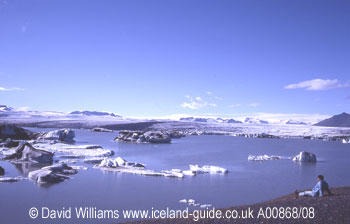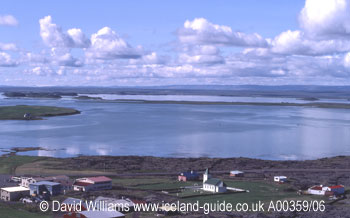 |
| The
glacial lake of Jökulsárlón. Just sit back and
watch the ice floes drift slowly towards the sea. |
 |
| The
village of Reykjahlíð sits at the northern shore of Mývatn
in northern Iceland. |
At Skaftafell
National Park, which sits just below Vatnajökull, visitors
have a marvellous chance to explore one of these glaciers as its snout
is only 1km from the campsite. Above the campsite, signposted walks on
the hillside lead over the moorland to viewpoints that are perched high
above the glacier. Only 50km farther along the ring road from Skaftafell
is the glacial lake of Jökulsárlón. Here, icebergs
crack off the edge of the 4km wide Breiðamerkurjökull
glacier into the lake and then drift slowly towards the sea. James Bond
visited the lake in the film A View to Kill in a submarine, but
tourists can take a more leisurely boat trip amongst the icebergs to get
a closer look at these cold but starkly beautiful natural sculptures.
Snowcat and skiddoo trips are available on nearby Skálafellsjökull,
another part of Vatnajökull.
Iceland sits atop the volcanic Mid-Atlantic Ridge, the long chain of mountains
that is being formed as the European and American continents move slowly
apart. Today, the two halves of the country are separating by about 2cm
a year and at Mývatn (a lake in the north-east of the country)
visitors can see the effects of the recent eruptions caused by this continental
drift. Since 1981, the district around the lake has been slowly rising
and falling because of the movements of molten rock deep below the surface.
On a number of occasions the ground has opened up along fissures, sending
tall fountains of red-hot lava high into the air. Although there have
been no eruptions since 1984, the ground is still moving and the hot rocks
below the surface are still giving off gases that have a strong sulphurous
smell. Near the eruption site are tongues of fresh black lava, large pools
of hot bubbling mud and deposits of sulphur. Wisps of vapour rising lazily
from the fissures add to the excitement of exploring such a place. The
name "Mývatn" means "midge lake" and countless
numbers of these insects provide the food for many of the district`s birds.
Mývatn is one of Europe`s most important wildfowl breeding areas,
and ornithologists come from all over the world to see the lake`s tens
of thousands of birds which include Barrow`s goldeneye, harlequin, whooper
swan and great northern diver.
Back
to the list of articles about this country
|

